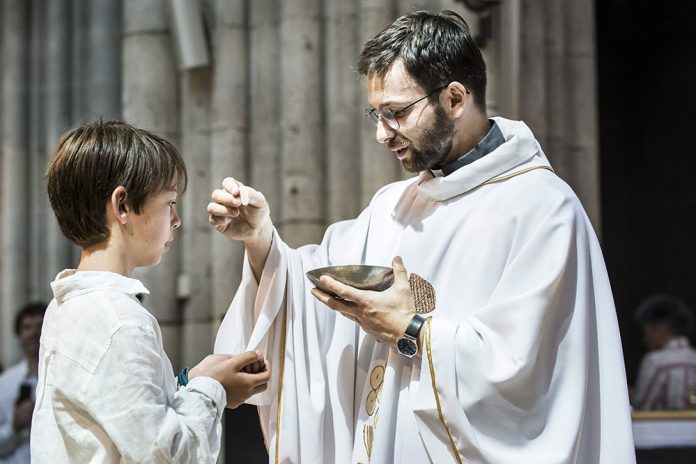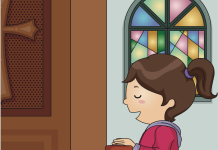
Teaching about Holy Orders
CARRIE SOUKUP
My faithful, dynamic, fill-the-church pastor was schooled by volunteer religious education teachers. He was (and still is) your average wise-cracking, fun, imperfect yet lovable guy. Years ago, no one would have guessed that this student in the back of class had a call to the priesthood, but God works miracles through everyday, ordinary people like you and me.
The effect of a good priest is vast. Every week, one solitary priest feeds hundreds of people, anoints the sick, forgives dozens of wearied souls, and comforts families who have lost loved ones. If you think about the power of the sacraments — such as marriage or the Eucharist — you know you have a priest to thank. Everyone in the world has a role to play in the glorious unfolding of God’s plan, and it becomes obvious to us what a lynchpin a priest is for all of us Catholics.
Many have heard that there is currently a priest shortage; there is approximately one priest for every 3,000 Catholics worldwide (one to 2,000 in the United States). While seminaries are not full, they are still continuing to form holy men to serve the spiritual needs of millions of Catholics. Perhaps someone in your own classroom may be called by God someday to become one of these pivotal servants of God.
But just like the floor beneath us, if we do not focus on it, we will take it for granted and not enjoy the gift that is ours. I have found that my own appreciation of the priesthood greatly increases as I study vocation and the sacraments. So, with that in mind, I have a few tips to make it easy for you to try out a lesson in your religious education class on the priesthood.
The grace of priesthood reaches far. My church is packed because of the outreach of our pastor and the “yes” he said to God’s calling. Your students have a mission, too. Thank you for supporting them in receiving the grace of the sacraments and saying their own “yes” day by day on the path of mission.
LESSON PLAN
Starting activity
Have coffee filters on the tables or desks when children arrive. Invite them to decorate the filters with magic markers, making various colors and designs. Tell them that the colors represent the good work in life that kids and adults do. With the sacraments, the things we do take on a heavenly meaning. When the children are finished, walk around and spray each coffee filter with a water bottle. The colors will blend and form a tie-dye pattern. We all have a special role in life, and the priest’s role is to administer the sacraments (like bringing the water bottle spray to people). All of us working together make something beautiful.
Targets
Mind: Understand the role of a priest.
Heart: Feel affection for the sacraments and gratitude to God for calling people to be priests.
Soul: Actively participate in the sacraments.
Strength: Be open to God’s calling.
Learning Points
1. A priest brings grace (administers the sacraments). The main role of a priest is to bring the grace of God to people through the sacraments. A sacrament is an efficacious (powerfully effective) outward sign of an inward grace that has been instituted by Jesus. The five sacraments that a priest can administer are Baptism, Eucharist, Penance and Reconciliation, Anointing of the Sick, and Matrimony. These sacraments are necessary and powerful for people living a Christian life.
(Confirmation and Holy Orders are reserved for bishops to administer.)
2. Christ is present to his Church through the priest (in persona Christi). When a man becomes a priest, his soul is given an indelible mark — a special presence of Christ (similar to the way your soul was marked when you were baptized). While this does not prevent a priest from ever doing bad things (in the same way that Baptism does not turn you into a robot who can only do good), it does mean that Christ himself is serving the Church through the sacramental work of the priest.
3. A priest’s mission is to serve as Christ (lay down his life). Jesus came to lay down his life so that we might have life. A priest is supposed to model his life after Jesus and do the same thing: sacrifice his life for the people. This takes place in many ways through a deep life of daily prayer, penance, and action. A priest may often move from a funeral, to a meeting, to a trip to the hospital, to a church event, and back to prayer. Priests go where they are needed. They do not get married so they can dedicate their whole time to the family of God, the Church — which, in a way, is a priest’s bride.
4. A priest is called by God (vocation to Holy Orders). God calls everyone to some special mission in life. Right now, your calling (as a young person) is to be a light to the world as a single person. You are to learn and love. Later you may be called to serve God and the world through marriage. Priests are men who have been called by God to serve him and the world through the sacraments. God calls through an inner feeling, prayer, your skills, your hopes, your circumstances, the Church, and your friends and family.
5. A priest needs to have a good character (yet just human). In order to be a priest, God needs men who have good character — people who are truthful, wise, loving, and patient. Unfortunately, not all priests continue to turn to God to work on their goodness. Some priests do bad things. We can pray for our Church to have good, holy, awesome men who become priests. All Christians are called to have a good character. We can build up the Church by turning to God to make us good. As you become holy, you will become more and more ready to do the mission that God has planned for you!
You can write the learning point summary on the board as you discuss each point. Most students are visual learners, and it can help to see a few words to focus their thinking. Too many words while you are talking will be confusing. Alternatively, for older students, you could print these points and distribute them to each person. You may need to switch up the way you teach each point, especially for children in second grade and younger. Some points may be straight discussion, while others you can teach by weaving it into a craft, game, reading, or prayer. For background, you can read the Catechism of the Catholic Church (see paragraphs 1536–1600).
Discussion
Questions for open-ended opinion and experience discussion
■ When have you met a priest? What was your experience?
■ How does God “call” someone to do a job or a mission?
■ Can you imagine God calling you to do something?
■ How have you seen people lay down their lives for others?
■ How can you make your character good and ready for mission?
■ What are some good ways to foster reverence and openness to the power of the sacraments?
Game
1. Pack a bag for things a priest will need “on mission.”
2. Bring to class a scarf that you can pretend to be a stole.
3. Have a volunteer say, “I’m going on a mission from God. I will need to bring ________, _________, and _________.” The student should say two things that a priest would not really need and one thing that he will.
4. Whoever gets the answer right can come up, wear the stole, and say a new batch of words. Depending upon the age, try to introduce words such as chalice, Bible, lectionary, vestments, etc.
Prayer
God, thank you for the gift of the priesthood. Thank you for the power of the sacraments which you bring to us through our priests. Open our whole lives to the transforming grace of your sacraments. Please protect your priests and fill them with holiness. Protect and sanctify us, as well. We will listen to you as you call us into mission with the whole Church. Help us to be ready and willing to meet you through the prayers and service we do. Amen.
Tips
■ Make the experience of grace personal. Don’t be afraid to share your own experiences with the sacraments.
■ At some point, mention that some priests have done bad things. Do this simply, generally, and without fanfare — not causing any fear or anxiety in the children or sharing details. It is good that they very briefly hear this from you, a loving Catholic. Help them to keep confidence in the sacraments and God’s provisions.
■ Invite a priest to class and ask for his blessing.
■ Post Mass and Sacrament of Penance and Reconciliation times.
■ Share the contact information of your priest or deacon.
CARRIE SOUKUP, MA, is a catechist and high school teacher in the northwest Chicago suburbs. Find her stories and tips for flourishing in prayer at GraceFinders.com.
PHOTO: CORINNE SIMON/CIRIC
This article was originally published in Catechist, April-May 2020.




